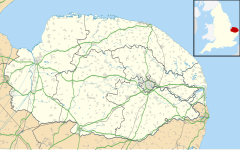Great Snoring
| Great Snoring | |
|---|---|
 Great Snoring houses and war memorial |
|
|
Great Snoring shown within Norfolk
|
|
| Area | 6.85 km2 (2.64 sq mi) |
| Population | 143 (2011) |
| • Density | 21/km2 (54/sq mi) |
| OS grid reference | TF946345 |
| • London | 105 mi (169 km) SSW |
| Civil parish |
|
| District | |
| Shire county | |
| Region | |
| Country | England |
| Sovereign state | United Kingdom |
| Post town | FAKENHAM |
| Postcode district | NR21 |
| Police | Norfolk |
| Fire | Norfolk |
| Ambulance | East of England |
| EU Parliament | East of England |
Great Snoring (archaic English: Snoring Magna) is a rural village in North Norfolk by the River Stiffkey, in the east of England. It is situated approximately 25 miles (40 km) north-west from the city and county town of Norwich, and 2 miles (3 km) north from the larger village of Little Snoring.
At the centre of the village are the listed buildings of St Mary's Church and the Old Rectory. The village main street comprises houses of brick and flint. The nearest inn and shop is in Little Snoring.
Village population in the 2001 Census was 168, reducing to 143 at the 2011 Census.
The 1086 Domesday Book calls the village by the Saxon name Snaringa/Snarringes, named after an inhabitant called Snear. The book includes mention of a water mill, which now features on the village sign.
In 1611 Sir Ralph Shelton, lord of the manor, sold Great Snoring to Lord Chief Justice Richardson. Sir Ralph is reported to have said "I can sleep without Snoring".
John Pearson (1612–86), the English divine and scholar, was born in Great Snoring on 28 February 1612.
Francis White's 1854 History, Gazetteer and Directory of Norfolk describes the village as having as 99 houses, with a total population of 656, and with John Dugmore, Esq as lord of the manor. The church, dedicated to the Virgin Mary, is described as having a "fine tower" (formerly a spire), containing curious old brasses of the Skelton family. White notes the rectory house, built by the Skelton family, as a "fine specimen of ornamental brick work", valued at £24 and occupied by Rev D.H. Lee Warner. The Walsingham Union House, a workhouse, contained 164 staff and occupants.
On 12 April 1836 Walsingham Poor Law Union was formed, and a new Walsingham Union workhouse was built at Great Snoring in the same year to accommodate up to 250 inmates. The architect was William Thorold, and he based it on Sampson Kempthorne's model cruciform plan published by the Poor Law Commissioners in 1835. Four accommodation wings were joined to a central supervisory area, allowing segregation of different categories of inmate. Areas between the wings were used as exercise space. Workshops and service buildings around the edge gave the overall site an octagonal shape. To the east of the site a chapel was built.
...
Wikipedia

